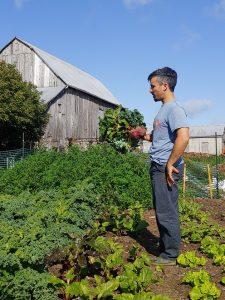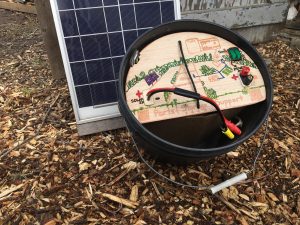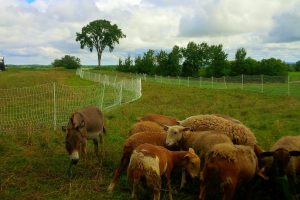 Cavaleiro Farm is a 65-acre agroecological farm in Schomberg, Ontario, that’s shining the light on solar energy’s versatile on-farm applications.
Cavaleiro Farm is a 65-acre agroecological farm in Schomberg, Ontario, that’s shining the light on solar energy’s versatile on-farm applications.
The York Region farm, run by Antonio Gomes, raises lambs, grows vegetables for a CSA, plants fruit trees, and provides land for local food businesses to rent out.
As the farm operation grew over the last few years, Antonio started building small solar energy systems on the family farm — and now, he’s launching courses and online resources to share the cost-saving process with others.
“I always ask myself, how can we co-create farms that empower communities?” says Antonio, who completed his Masters thesis on agroecological farm design.
Antonio began using solar energy about four years ago with a small water project that pumped water from the well to their barn. Now Cavaleiro Farm is harnessing solar energy for all of their water systems: for all watering, the livestock—which includes lambs, chicken, ducks, pigs and a donkey—and for the water supply in the kitchen.
The five local businesses that are currently renting space on the farm also employ the solar energy systems; for instance, one farmer who is growing corn for fresh tortilla is utilizing solar electric fencing to keep wildlife out.
3 Days to Self-Reliance with Solar, the second version of the online course, will launch in January 2020.
Designed specifically for farms or gardens, the online course provides a step-by-step guide to building and running small solar energy systems, covering a breadth of on-farm applications, including water management, electric fencing, charging, and small appliance needs. Course participants will also build a solar energy solution that solves a problem or accomplishes something specific to their farm.
In addition, Antonio has also made a free e-book and designed a free solar energy masterclass on how others can use solar energy to make farm or garden work easier.
Antonio is clearly eager to share this knowledge with others so they too can save time and money. When he first began looking to convert to solar, Antonio received quotes around $20,000; after some research, he came to the conclusion that it would be a lot more manageable to gradually implement the systems himself.
Starting with a small system, he explains, also makes it easier to learn how you can use solar energy.
Cavaleiro Farm is not “off the grid”—they still buy some energy—but partially transitioning to solar in stages has proven its versatility.
“Solar allows me to have power anywhere on my farm,” Antonio shares. “A lot of places where you can’t run an extension cord, I have solar now. The transition has allowed me to really learn about the energy and how I use it in different ways on the farm. Now I can kind of think with solar energy in mind as I grow my farm and operation.”
The course syllabus explains that solar energy can solve many common problems on the homestead or farm, bringing water and energy to wherever they’re needed.
“And if the power goes out, it doesn’t affect our water distribution!”
Learn more and find the free training at www.urbancrops.ca/solarclass/. If you’re interested to dig deeper into the application of solar energy, stay tuned on their website for the three-day course coming in January.
